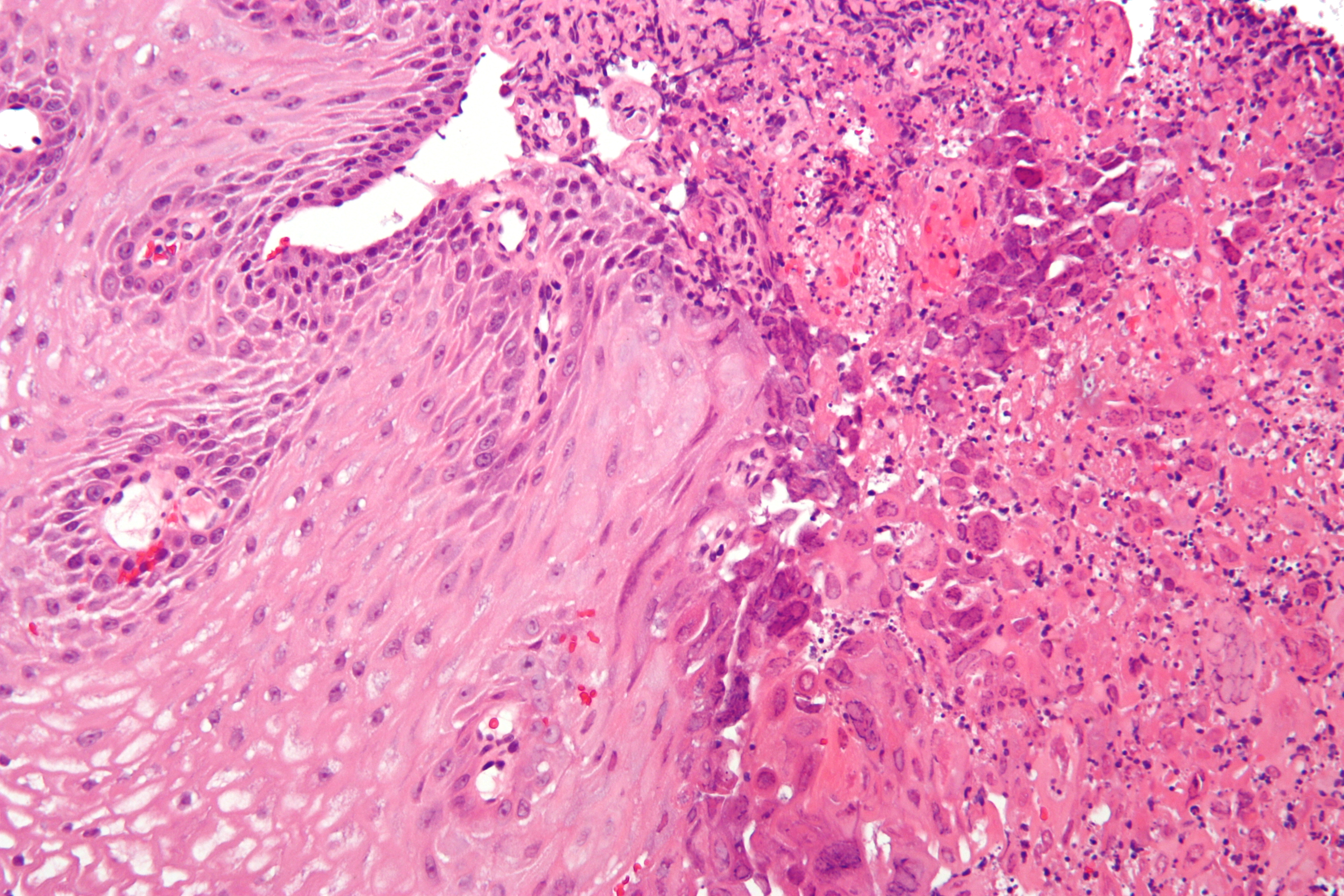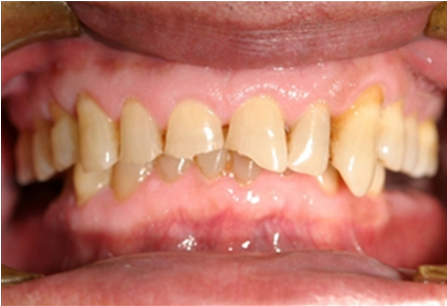|
Exomphalos
An omphalocele or omphalocoele, also known as an exomphalos, is a rare abdominal wall defect. Beginning at the 6th week of development, rapid elongation of the gut and increased liver size reduces intra abdominal space, which pushes intestinal loops out of the abdominal cavity. Around 10th week, the intestine returns to the abdominal cavity and the process is completed by the 12th week. Persistence of intestine or the presence of other abdominal viscera (e.g. stomach, liver) in the umbilical cord results in an omphalocele. Omphalocele occurs in 1 in 4,000 births and is associated with a high rate of mortality (25%) and severe malformations, such as cardiac anomalies (50%), neural tube defect (40%), exstrophy of the bladder and Beckwith–Wiedemann syndrome. Approximately 15% of live-born infants with omphalocele have chromosomal abnormalities. About 30% of infants with an omphalocele have other congenital abnormalities. Signs and symptoms The sac, which is formed from an outpou ... [...More Info...] [...Related Items...] OR: [Wikipedia] [Google] [Baidu] |
Beckwith–Wiedemann Syndrome
Beckwith–Wiedemann syndrome (; abbreviated BWS) is an overgrowth disorder usually present at birth, characterized by an increased risk of childhood cancer and certain congenital features. A minority (97th centile) * Macroglossia * Hemihypertrophy, Hemihyperplasia (asymmetric overgrowth of one or more regions of the body) * Omphalocele (also called exomphalos) or umbilical hernia * Embryonal tumor (e.g., Wilms' tumor, Wilms tumor, hepatoblastoma, neuroblastoma, rhabdomyosarcoma) in childhood * Organomegaly, Visceromegaly involving one or more intra-abdominal organs including liver, spleen, kidneys, adrenal glands, and/or pancreas * Cytomegaly of the fetal adrenal cortex (pathognomonic) * Renal abnormalities including structural abnormalities, nephromegaly, nephrocalcinosis, and/or later development of medullary sponge kidney * Anterior linear ear lobe creases and/or posterior helical ear pits * Placental mesenchymal dysplasia * Cleft lip and cleft palate, Cleft palate (rare in BWS) ... [...More Info...] [...Related Items...] OR: [Wikipedia] [Google] [Baidu] |
Congenital Abnormalities
A birth defect is an abnormal condition that is present at birth, regardless of its cause. Birth defects may result in disabilities that may be physical, intellectual, or developmental. The disabilities can range from mild to severe. Birth defects are divided into two main types: structural disorders in which problems are seen with the shape of a body part and functional disorders in which problems exist with how a body part works. Functional disorders include metabolic and degenerative disorders. Some birth defects include both structural and functional disorders. Birth defects may result from genetic or chromosomal disorders, exposure to certain medications or chemicals, or certain infections during pregnancy. Risk factors include folate deficiency, drinking alcohol or smoking during pregnancy, poorly controlled diabetes, and a mother over the age of 35 years old. Many birth defects are believed to involve multiple factors. Birth defects may be visible at birth or dia ... [...More Info...] [...Related Items...] OR: [Wikipedia] [Google] [Baidu] |
Hepatomegaly
Hepatomegaly is enlargement of the liver. It is a non-specific sign (medicine), medical sign, having many causes, which can broadly be broken down into infection, hepatic tumours, and metabolic disorder. Often, hepatomegaly presents as an abdominal mass. Depending on the cause, it may sometimes present along with jaundice. Signs and symptoms The patient may experience many symptoms, including weight loss, poor appetite, and lethargy; jaundice and bruising may also be present. Causes Among the causes of hepatomegaly are the following: Infective Mechanism The mechanism of hepatomegaly consists of Blood vessel, vascular swelling, inflammation (infectious in origin), and deposition of (1) non-hepatic cells or (2) increased cell contents (such as that due to iron in hemochromatosis or hemosiderosis and fat in fatty liver disease). Diagnosis Suspicion of hepatomegaly indicates a thorough medical history and Abdominal examination, physical examination, wherein the latter typicall ... [...More Info...] [...Related Items...] OR: [Wikipedia] [Google] [Baidu] |
Mortality Rate
Mortality rate, or death rate, is a measure of the number of deaths (in general, or due to a specific cause) in a particular Statistical population, population, scaled to the size of that population, per unit of time. Mortality rate is typically expressed in units of deaths per 1,000 individuals per year; thus, a mortality rate of 9.5 (out of 1,000) in a population of 1,000 would mean 9.5 deaths per year in that entire population, or 0.95% out of the total. It is distinct from "morbidity", which is either the prevalence or Incidence (epidemiology), incidence of a disease, and also from the incidence rate (the number of newly appearing cases of the disease per unit of time). An important specific mortality rate measure is the crude death rate, which looks at mortality from all causes in a given time interval for a given population. , for instance, the Central Intelligence Agency, CIA estimates that the crude death rate globally will be 7.7 deaths per 1,000 people in a population p ... [...More Info...] [...Related Items...] OR: [Wikipedia] [Google] [Baidu] |
Morality
Morality () is the categorization of intentions, Decision-making, decisions and Social actions, actions into those that are ''proper'', or ''right'', and those that are ''improper'', or ''wrong''. Morality can be a body of standards or principles derived from a code of conduct from a particular philosophy, religion or culture, or it can derive from a standard that is Universal morality, understood to be universal. Morality may also be specifically synonymous with "goodness", "appropriateness" or "rightness". Moral philosophy includes meta-ethics, which studies abstract issues such as moral ontology and moral epistemology, and normative ethics, which studies more concrete systems of moral decision-making such as deontological ethics and consequentialism. An example of normative Ethics, ethical philosophy is the Golden Rule, which states: "One should treat others as one would like others to treat oneself." Immorality is the active opposition to morality (i.e., opposition to that w ... [...More Info...] [...Related Items...] OR: [Wikipedia] [Google] [Baidu] |
Prognosis
Prognosis ( Greek: πρόγνωσις "fore-knowing, foreseeing"; : prognoses) is a medical term for predicting the likelihood or expected development of a disease, including whether the signs and symptoms will improve or worsen (and how quickly) or remain stable over time; expectations of quality of life, such as the ability to carry out daily activities; the potential for complications and associated health issues; and the likelihood of survival (including life expectancy). A prognosis is made on the basis of the normal course of the diagnosed disease, the individual's physical and mental condition, the available treatments, and additional factors. A complete prognosis includes the expected duration, function, and description of the course of the disease, such as progressive decline, intermittent crisis, or sudden, unpredictable crisis. When applied to large statistical populations, prognostic estimates can be very accurate: for example the statement "45% of patients with sever ... [...More Info...] [...Related Items...] OR: [Wikipedia] [Google] [Baidu] |
Umbilicoplasty
Umbilicoplasty, sometimes referred to as "belly button surgery", is a plastic surgery procedure to modify the appearance of one's navel (or "belly button"). It may be performed as part of a tummy tuck or lower body lift operation, or it may be performed alone. Reasons Candidates typically choose the surgery because they dislike how their navel looks. They may have a protruding or inverted navel, which they may wish to change. Their navel may be as it was from birth, or it may have changed due to unrelated surgery, such as a Caesarean section Caesarean section, also known as C-section, cesarean, or caesarean delivery, is the Surgery, surgical procedure by which one or more babies are Childbirth, delivered through an incision in the mother's abdomen. It is often performed because va .... Another fairly common reason is because of dramatic weight loss or pregnancy, which can change the shape of a belly button. Some may have experienced weight gain, weight loss, or pregnancy, ... [...More Info...] [...Related Items...] OR: [Wikipedia] [Google] [Baidu] |
Tissue Expansion
Tissue expansion is a technique used by plastic, maxillofacial and reconstructive surgeons to cause the body to grow additional skin, bone, or other tissues. Other biological phenomena such as tissue inflammation can also be considered expansion (see tissue inflammation below). Skin expansion Skin expansion is a common surgical procedure to grow extra skin through controlled mechanical overstretch. It creates skin that matches the color, texture, and thickness of the surrounding tissue, while minimizing scars and risk of rejection. When skin is stretched beyond its physiological limit, mechanotransduction pathways are activated. This leads to cell growth as well as to the formation of new cells. In some cases, this may be accomplished by the implantation of inflatable balloons under the skin. By far the most common method, the surgeon inserts the inflatable expander beneath the skin and periodically, over weeks or months, injects a saline solution to slowly stretch the overlaying ... [...More Info...] [...Related Items...] OR: [Wikipedia] [Google] [Baidu] |
Navel
The navel (clinically known as the umbilicus; : umbilici or umbilicuses; also known as the belly button or tummy button) is a protruding, flat, or hollowed area on the abdomen at the attachment site of the umbilical cord. Structure The umbilicus is used to visually separate the abdomen into quadrants. The umbilicus is a prominent Scar#Umbilical, scar on the abdomen, with its position being relatively consistent among humans. The skin around the waist at the level of the umbilicus is supplied by the tenth thoracic spinal nerve (T10 dermatome (anatomy), dermatome). The umbilicus itself typically lies at a vertical level corresponding to the junction between the L3 and L4 vertebrae, with a normal variation among people between the L3 and L5 vertebrae. Parts of the adult navel include the "umbilical cord remnant" or "umbilical tip", which is the often protruding scar left by the detachment of the umbilical cord. This is located in the center of the navel, sometimes described ... [...More Info...] [...Related Items...] OR: [Wikipedia] [Google] [Baidu] |
Esophagitis
Esophagitis, also spelled oesophagitis, is a disease characterized by inflammation of the esophagus. The esophagus is a tube composed of a mucosal lining, and longitudinal and circular smooth muscle fibers. It connects the pharynx to the stomach; swallowed food and liquids normally pass through it. Esophagitis can be asymptomatic; or can cause epigastric and/or substernal burning pain, especially when lying down or straining; and can make swallowing difficult ( dysphagia). The most common cause of esophagitis is the reverse flow of acid from the stomach into the lower esophagus: gastroesophageal reflux disease (GERD). __TOC__ Signs and symptoms The symptoms of esophagitis include: * Heartburn – a burning sensation in the lower mid-chest * Nausea * Dysphagia – swallowing is painful, with difficulty passing or inability to pass food through the esophagus * Vomiting (emesis) * Abdominal pain * Cough Complications If the disease remains untreated, it can cause scar ... [...More Info...] [...Related Items...] OR: [Wikipedia] [Google] [Baidu] |
Gastroesophageal Reflux Disease
Gastroesophageal reflux disease (GERD) or gastro-oesophageal reflux disease (GORD) is a chronic upper gastrointestinal disease in which stomach content persistently and regularly flows up into the esophagus, resulting in symptoms and/or complications. Symptoms include dental corrosion, dysphagia, heartburn, odynophagia, regurgitation, non-cardiac chest pain, extraesophageal symptoms such as chronic cough, hoarseness, reflux-induced laryngitis, or asthma. In the long term, and when not treated, complications such as esophagitis, esophageal stricture, and Barrett's esophagus may arise. Risk factors include obesity, pregnancy, smoking, hiatal hernia, and taking certain medications. Medications that may cause or worsen the disease include benzodiazepines, calcium channel blockers, tricyclic antidepressants, NSAIDs, and certain asthma medicines. Acid reflux is due to poor closure of the lower esophageal sphincter, which is at the junction between the stomach and ... [...More Info...] [...Related Items...] OR: [Wikipedia] [Google] [Baidu] |






